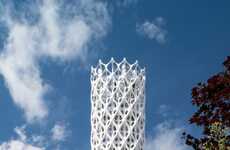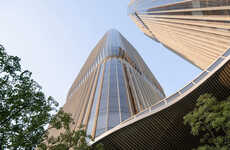
Adrian Smith + Gordon Gill Designs the Tallest Building in China
The tallest building in China will soon no longer be the Shanghai Tower (632 m). Adrian Smith + Gordon Gill Architecture won the opportunity to design the Shenzhen-Hong Kong International Center. Located in Shenzen, the structure will reach 700 meters in height upon completion. It will serve as a performance venue and, of course, will feature "the world's highest observation deck."
Taking cues from the project's intended functionality, Adrian Smith + Gordon Gill Architecture conceives the soon-to-be tallest building in China with "a muscular expression." In addition to aesthetics, the firm focused on producing a tower that would guarantee a sustainable use of energy. With this in mind, the facade of the Shenzhen-Hong Kong International Center boasts a high-performing glass facade for heat reduction, plenty of opportunities for natural light, natural ventilation, rainwater collection, among other features.
Taking cues from the project's intended functionality, Adrian Smith + Gordon Gill Architecture conceives the soon-to-be tallest building in China with "a muscular expression." In addition to aesthetics, the firm focused on producing a tower that would guarantee a sustainable use of energy. With this in mind, the facade of the Shenzhen-Hong Kong International Center boasts a high-performing glass facade for heat reduction, plenty of opportunities for natural light, natural ventilation, rainwater collection, among other features.
Trend Themes
1. High-performing Glass Facade - The trend of incorporating high-performing glass facades in building designs can disrupt the architecture industry by offering sustainable solutions for heat reduction and energy efficiency.
2. Natural Ventilation - The trend of utilizing natural ventilation systems in building designs presents disruptive innovation opportunities for the HVAC industry, providing energy-saving alternatives to traditional air conditioning systems.
3. Rainwater Collection - The trend of implementing rainwater collection systems in building designs creates disruptive innovation opportunities for the water management industry, allowing for sustainable water usage and conservation.
Industry Implications
1. Architecture - The architecture industry has the potential to be disrupted by advancements in sustainable building materials and design concepts, such as high-performing glass facades and natural ventilation systems.
2. HVAC - The HVAC industry can embrace disruptive innovation by exploring and implementing natural ventilation systems as energy-efficient alternatives to traditional air conditioning methods.
3. Water Management - The water management industry can leverage disruptive innovation by incorporating rainwater collection systems into building designs to promote sustainable water usage and conservation.
5.1
Score
Popularity
Activity
Freshness























